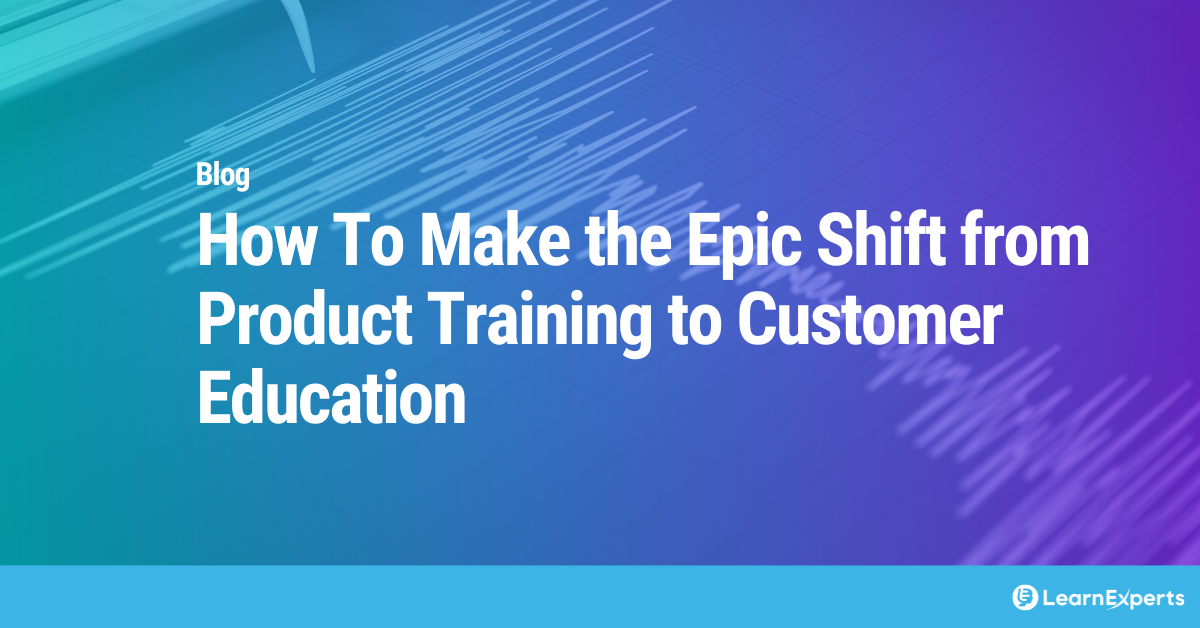I recently hosted a webinar with CEdMA (Customer Education Management Association) President, Debbie Smith, and we touched on a perennial topic: How to move from product training to customer education. Some of you who are reading this might be saying – Hey! We take a customer approach to training! We help our customers learn about the features of our product so they can save [time | money | effort].
While understanding the features of a product is important, I would argue that customer education is different and in this blog I will review some of the memorable points from our conversation as well as, my thoughts on how to make this epic shift.
What is customer education?
Unlike product training, which teaches someone how to use a product or service, customer education is the process of teaching how to achieve a specific outcome. Not only does customer education include product education, it may also include industry-related training and best practices.
While we often think that customer education is only for paying clients, the definition has been broadened to include internal customers (like sales, customer support and marketing) who need to learn how to do specific jobs.
Why customer education is important?
When you go beyond training your customers on your products, you build greater brand loyalty. Your company becomes a trusted partner to solve your client’s problems.
Customer education also helps to:
- Improve customer satisfaction: When customers understand your product and how to solve their problems, they are more likely to be satisfied with your organization.
- Greater product adoption: Educated customers can leverage all features and benefits of your product or service.
- Reduce support costs: Educated customers or those who know how to get the information they require, are less likely to encounter issues or require assistance.
- Competitive advantage: A strong customer education program can differentiate a company from its competitors.
- Reduced customer churn: Strong customer loyalty increases customer retention as it helps to reduce the risk of customers looking around for alternate solutions.
How can you improve customer education? Stop talking about features!
How many times have you heard “Why can’t your instructional designers move faster?”? This is not an uncommon question from the C-suite. I have spent many hours explaining to my peers in the C-suite that organizations need to cognitively shift how they look at education in the subscription economy.
Long gone are the days (especially in the SaaS world!) of building thick product manuals that we give to our customers and connect with them before the next product release. Gone also are the days when successful companies build scores of PDFs and videos that teach people how to use software just so that they know how to use the software. That’s not the point of customer education.
Customer education is there to deepen the value customers are getting from your solution which ultimately results in increase feature adoption and up/cross-selling to those customers. So, we really must stop creating programs that focus only on how to use every feature of the product. Instead, we need to create programs that focus on how we help customers grow their business through our solution.
Customer success must evolve too
Customer success teams have similar issues in relying on antiquated strategies and processes to engage with clients. Gone are the days when account managers would only engage with customers when there was a problem (and tried to upsell simultaneously).
Today’s successful customer success models are continuous and proactive. They’re continuously connecting with customers to try to mitigate problems by engaging in regular conversations with the customer. “Hey, how’re you doing today? I saw that your software utilization was up/down and I was wondering if I can help you with anything specific.”
Customer success needs to be continuously engaging, continuously teaching, continuously learning, and continuously partnering with the customer.
Moving from onboarding to everboarding
For success, customer education means moving away from the old model of one-time training engagements, where the customer is onboarded and then only engaged with when they have a support issue. Instead, think about it as everboarding, where customers are continuously engaged with the organization and product through learning.
With everboarding, you need to take the approach of never being “done” educating the customer on how they can get value from your product. You also need to assume that each new user adopting your product needs to be initally onboarded and then continuously everboarded following that.
For new users, onboarding requires identifying and verifying the core customer use cases that your product addresses, identifying the learning path that best suits them and then enrolling them in the appropriate learning program. Ideally there is a mix of consultation, education and planned re-engagement to continue with and everboarding when initial onboarding actions have been completed.
For customer training teams, you can measure everboarding through course enrollments and completion rates by customers. You also need to look at other corporate metrics like annual recurring revenue (ARR), customer churn, time-to-value, customer acquisition costs (CAC), long-term value (LTV), net promoter scores (NPS) and customer satisfaction (CSAT) to demonstrate how education is contributing to these.
When designing programs, they should also measure success about how their learning helps to move the needle with these metrics.
Customer education training for product-led growth
In product-led growth (PLG), product drives acquisition. Usually, you start with a free trial or a freemium model to help the product sell itself. There are varying degrees of how successful organizations have done this but the key thing with product-led growth is it’s a tech touch model.
Customer education training strategies with product-led growth will vary depending on the challenges being faced to get customers to upgrade.
According to Skilljar, if your challenge is long time to value, focus on training customers on what’s relevant to them at that point in time. To this, use emails and in-app tools to encourage learning and engagement.
If the challenge is low product adoption, look to build customer education that is persona-specific. This is where you move away from feature training and focus the content on explaining how it’s going to benefit them on a day-to-day basis. Also, use data to understand where training is needed.
Finally, if the challenge is high support costs, identify the areas that receive the most questions and build content to address these questions. Skilljar also recommends embedding training content within your knowledge base and community.
Customer education for sales-led growth
Sales-led growth is usually much more of a high-touch model. Sales usually start with demos and unfortunately, often tend to focus on the product features. A customer’s use case is not the same as a product use case.
With sales-led growth, effectively training the sales team to inquire about what the customer does in their day-to-day business and the problems that they encounter is critical. In addition to learning how to consult with customers, the customer education teams need to prepare sales to show the product to help customers achieve efficiencies in their day-to-day work and solve the problems they have identified.
Customer education metrics
Moving from product training to customer education means a shift in how you measure success. With product training, teams may look at metrics like number of course attendees, views, or course completion rates. When you move to customer education, you want to look for metrics that show business growth. Here are 5 metrics to consider.
Customer Acquisition Cost (CAC)
CAC = (Cost of Sales + Cost of Marketing) / New Customers Acquired
CAC is the amount of money a company spends to gain a new customer. To calculate CAC, you add your sales and marketing expenses and divide it by the total number of new customers you gained during a specific time period.
Customer education can reduce the cost of sales and marketing. A positive onboarding and everboarding experience will help drive positive product reviews and referrals which will support new customer acquisition.
Customer Churn
Customer Churn Rate = (Customers beginning of the month — Customers end of the month) / Customers beginning of the month
Customer education is an effective way to prevent churn and increase customer retention because it helps the customer to discover how the product can help to meet their day-to-day needs. Good education also leads to higher product adoption and customer satisfaction, which reduces the likelihood of a customer leaving.
Customer Engagement
Measuring customer engagement will vary with each organization. But what we know is that a good customer education program will drive a deeper relationship with your company’s brand. This leads to higher customer loyalty and lower customer churn.
Customer Satisfaction (CSAT) and Net Promoter Score (NPS)
CSAT = Happy customers/Number of customers asked
Net Promoter Score = Number of promoters/Number of detractors
Like customer engagement, customer education increases customer satisfaction which will typically lead to an increase in the NPS score.
Customer Lifetime Value (CLV)
Customer Lifetime Value = (Customer Value * Average Customer Lifespan)
When customer education can facilitate product adoption, this builds loyalty and creates recurring business which increases customer value and customer lifespan.
Getting started with your customer education strategy
Determine goals: To get the most out of your customer education program, it is essential to start by defining its goals. This will provide you with a comprehensive view and understanding of what you are trying to accomplish, as well as serve as an empirical indication for assessing the success rate of your training program.
Assess your current customer education program: After you have established your objectives, examine any existing training materials that your company is using. Gain a thorough understanding of what the business does and the resources or materials available and begin devising the elements to build an effective ongoing learning experience for customers.
Map out your customer learning journey: A learning journey is a collection of both formal and informal educational activities, interventions, reminders, and follow-ups that deeply engrain customers with new knowledge and behaviors. Companies can benefit significantly from learning journeys, as these are constructed with specific business goals and objectives in mind. They also help to provide a roadmap of how and where to invest training resources.
For each step in the learning journey,
- Define the learning goals and objectives
- Identify subject matter experts (SMEs)
- Capture content ideas
- Define the delivery method for the content
- Define the length of the content
Create your learning content: If you’re looking to quickly roll our learning content that is captivating and engaging, consider using a course authoring tool such as LEAi. This tool will allow you to leverage existing content that is created by your SMEs and deliver your learning content in your preferred format (eLearning, instructor-led training, webinars, microlearning, etc.). LEAi will even create the test questions automatically so you can incorporate appropriate assessments into your learning courses.
Deliver and measure learning content: Once you have your learning content, it is time to make it available to customers. Many companies opt for a learning management system (LMS) for their eLearning courses and microlearning. If you are looking for an LMS, here are 10 things to look for in an LMS
- Ease of use
- Simple learning content uploading
- Course management features
- Simple and configurable training path management
- Media compatibility
- Quizzing and testing
- Reporting and analytics
- Gamification capabilities
- Automated admin tasks
- Platform integrations
Read How to choose the right LMS to get more details about choosing the right LMS for you.
Customer education software
Customer education has to rely on a host of software tools to deliver their training.
Learning content creation tools like course authoring technology helps to make learning content design and development easier. With stand-alone authoring tools (like LEAi), you create content in the authoring tool, export it and then import it to your learning management system (LMS).
eLearning production tools are needed if the content is going to be converted into self-paced eLearning. Examples of eLearning production tools include Adobe Captivate, Articulate Rise, and Lectora (to name just a few).
Learning delivery tools include virtual classrooms, learning management systems (LMS), learning experience platforms (LXP), and VM-ware-like tools.
If you opt for virtual in-person training, you will need video conferencing tools like Zoom, Microsoft Teams, and Webex to create virtual classrooms. With an LMS, you can deliver self-paced training and tools in this category include SkillJar, Docebo, Axonify, Thought Industries and Absorb, to name just a few.
An LXP is an AI-driven learning experience that provides a service like an LMS but allows learners to have a personalized learning experience. LXPs typically support a wide variety of content and have social features that enable end users to create and publish content, along with social profiles that feel like a social media experience. The popularity of these tools is exploding.
VMware-like tools support in-class training, virtual classroom, and eLearning with a hands-on “try-me” type experience. The aim of these solutions is to provide the learners with the opportunity to perform the tasks they are learning to solidify their knowledge.
Tips for customer education best practices
Stick to bite-sized learning: In today’s era of on-the-go learners who require knowledge when they need it, microlearning is an essential tool to keep learners engaged and allow information retention. To make use of microlearning, break a one-hour online lesson into shorter segments labelled as ‘microlessons’. By doing so, you will ensure that students are not overwhelmed with too much material all at once!
Add testing and gamification: Adding quizzes, interactive content and time limits is an effective way to engage learners. Gaming elements can also add interest.
Use a variety of learning styles: Not everyone learns the same way. Opt for different styles to engage visual, auditory, kinesthetic, logical, and social learners.
Personalize content: Make your training courses personal and relevant to the individual learner. You can do this by adding a personalized touch, such as inputting their name into the welcome page, customizing their end-of-course screen, or creating groups within your LMS. Doing so will make them feel valued and provide an enhanced learning experience!
Develop course content designed for optimal learning: There are established learning frameworks that help instructional designers to build content that is designed for optimal learning. Choose between ADDIE, Bloom’s Taxonomy or our preferred Tell me. Show me. Let me try. Test me approach to create wells-structured learning content.
How LEAi improves customer education
Making the cultural and educational switch from product training to customer education can be hard. However, once you make the shift, you will see a remarkable change on how your clients engage with you.
To make the transition easier, consider using our course authoring tool so you can accelerate your learning content creation and roll out more courses that fit your new strategy. LEAi is so easy to use – simply upload your presentations, documents, blogs and wikis, and LEAi will automatically build your learning objectives, learning content and test questions.
Let us show you how LEAi can be used within your organization!




